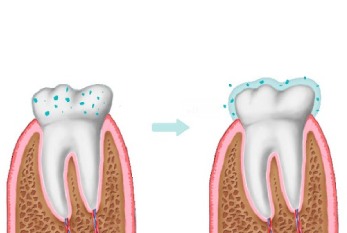Fluoridation of teeth

specialists

equipment

treatment
How does regular fluoridation differ from deep fluoridation?

The standard processing method involves the use of sodium fluoride. As a result, a layer of insoluble calcium fluoride (CaF2) is formed on the tooth surface. It is this that is the source of fluoride ions intended to restore the protective layer. This low solubility layer provides long-lasting but low-intensity protection.
Deep technology is carried out to eliminate the problem of enamel abrasion. The highly dispersed magnesium fluorosilicate used in this method penetrates into the smallest cavities of tooth enamel and is stabilized by calcium hydroxide.
During the treatment of teeth with fluoride, a layer of calcium fluoride (CaF2) is formed under the protective enamel. This layer is not subject to wear and tear when chewing food. Thanks to this, the deep coverage effect lasts much longer. This helps prevent tooth decay and strengthen teeth for a long time. In addition, the preparation for deep processing contains copper fluorosilicate, which has a strong antimicrobial effect. The only disadvantage of this method is the high cost.
Types of fluoridation and indications for enamel fluoridation
Dental clinics use two available methods of fluoride treatment: regular and in-depth.
The procedure, carried out using simple technology, involves the use of fluorine-containing varnish. The product that creates a transparent protective shell is applied with a brush.
The advanced method additionally involves the use of electrophoresis. This procedure improves the penetration of fluoride molecules through dental tissue. This effect is achieved thanks to soft electrical impulses soaked in a 10% calcium solution.
After this, the dentist installs individual trays containing fluoride on the teeth. Then the doctor treats the teeth with a special “sealing” preparation that preserves fluoride compounds for 1.5 years.
Fluoridation of enamel is recommended against the background of its damage. Against this background, its sensitivity increases: when it comes into contact with hot, cold, sour and sweet, discomfort or even pain occurs. Enamel strengthening is also carried out after completion of orthodontic treatment.

Other indications:
- As a measure to prevent caries Especially with an increased likelihood of demineralization of the protective layer. This is relevant during pregnancy and breastfeeding, as well as metabolic disorders and mineral deficiency.
- To restore the strength of hard tooth tissues Relevant before installing a filling. The procedure increases the strength of the dental crown and improves the retention of the filling.
- When correcting non-carious damage to dental units And also with underdevelopment of enamel, erosion, pathological abrasion and wedge-shaped defects. The procedure helps strengthen the protective layer, restore its structure and appearance, as well as reduce tooth sensitivity.
- Before the teeth whitening procedure The procedure strengthens weakened enamel and helps minimize the risk of tooth sensitivity.
General information about the procedure
Answers to popular questions
K+31 dental specialists commented on the most common questions about the procedure.
How often can teeth be fluoridated?
Is there an age limit for fluoridation?
Is it possible to undergo fluoridation during pregnancy?
What alternatives are there to fluoridation to strengthen enamel?
As an alternative to fluoride strengthening, calcium and phosphate based procedures are used. They also promote remineralization (the process of restoring minerals in the structure of tooth enamel) and strengthening the protective coating.
The use of specialized remineralizing pastes and gels is allowed. You should also visit your dentist for professional teeth cleaning using remineralizing agents.

Modern methods of diagnostics and dental treatment at "K+31"

This award is given to clinics with the highest ratings according to user ratings, a large number of requests from this site, and in the absence of critical violations.

This award is given to clinics with the highest ratings according to user ratings. It means that the place is known, loved, and definitely worth visiting.

The ProDoctors portal collected 500 thousand reviews, compiled a rating of doctors based on them and awarded the best. We are proud that our doctors are among those awarded.
Make an appointment at a convenient time on the nearest date
Price
Other Services
Онлайн консультация стоматолога-ортопеда
Diagnosis and treatment of TMJ diseases Axiography of the TMJ Condylography of the TMJ MRI TMJ Splint therapy for TMJ Total dental rehabilitationOcclusion Analysis
Digital Smile Design (DSD) CEREC ceramic crowns, vineyards and deposits: 1 day manufacture and installation Boxing tire Ceramic veneers Composite veneers Veneers on the front teeth Nobel Biocare Implants






















































Features of Alpha-Bio implants
Teeth fluoridation is a procedure for strengthening tooth enamel. Fluoride promotes enamel remineralization. After treatment, it becomes more resistant to acid attack, which in 90% of cases causes tooth decay.
In order to maintain a long-term protective effect, the coating should be renewed regularly.